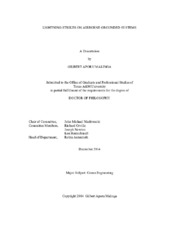| dc.contributor.advisor | Niedzwecki, John M | |
| dc.creator | Malinga, Gilbert Aporu | |
| dc.date.accessioned | 2015-04-28T15:29:43Z | |
| dc.date.available | 2016-12-01T06:36:02Z | |
| dc.date.created | 2014-12 | |
| dc.date.issued | 2014-10-13 | |
| dc.date.submitted | December 2014 | |
| dc.identifier.uri | https://hdl.handle.net/1969.1/153905 | |
| dc.description.abstract | The modeling of lightning strike behavior and estimation of the subsequent electrical discharge is of great practical importance. In this study a complete two-dimensional physics based analytical formulation is presented for elevated grounded systems that can be envisioned to be contained within two non-concentric circular domains. The inner circle encompasses the body or system of interest and the periphery of the outer circle addresses the cloud coverage and ground surface. The potential field between the circular domains is modeled as the sum of two separate contributions. The first is formulated in terms of an eigen-function expansion involving simple radial functions and Legendre polynomials, while the second contribution is developed using two different approaches. The first approach utilizes an eigen-function expansion incorporating spherical Bessel functions and Legendre polynomials, while the second approach uses a Green’s function formulation also involving orthogonal polynomial functions. Each of the contributions to the total potential field lead to linear systems of equations that are solved for the unknown series expansion coefficients. The accuracy of the potential field solution is investigated with regards to convergence, stability and error when compared with an exact solution. The potential field solution is then used as the basis to evaluate leader formation, regions of high risk, surface electrical charge and lightning collection area as a function of key parameters. The results indicate that the regions of high risk and surface electrical charge on an airborne structure are very sensitive to elevation, size of structure, cloud and leader parameters. The probability of lightning attachment on the airborne structure was shown to increase with elevation and extent of cloud coverage and decrease with increase in diameter of the elevated structure. Further, the lightning collection area around the airborne structure was shown to increase with elevation and leader peak current. The electrical discharge, estimated using electrical current, is shown to be in the range of presently available data. The findings of this research study have practical implications for design and operation of tethered airborne systems. | en |
| dc.format.mimetype | application/pdf | |
| dc.language.iso | en | |
| dc.subject | Lightning strikes | en |
| dc.subject | physics based methodology | en |
| dc.subject | eigen-function expansions | en |
| dc.subject | special functions | en |
| dc.subject | Green’s functions | en |
| dc.subject | convergence criteria | en |
| dc.subject | numerical stability | en |
| dc.subject | error estimation | en |
| dc.subject | joint probability functions | en |
| dc.subject | electrical discharge estimates | en |
| dc.title | Lightning Strikes on Airborne Grounded Systems | en |
| dc.type | Thesis | en |
| thesis.degree.department | Civil Engineering | en |
| thesis.degree.discipline | Ocean Engineering | en |
| thesis.degree.grantor | Texas A & M University | en |
| thesis.degree.name | Doctor of Philosophy | en |
| thesis.degree.level | Doctoral | en |
| dc.contributor.committeeMember | Newton, Joseph | |
| dc.contributor.committeeMember | Reinschmidt, Ken | |
| dc.contributor.committeeMember | Orville, Richard | |
| dc.type.material | text | en |
| dc.date.updated | 2015-04-28T15:29:43Z | |
| local.embargo.terms | 2016-12-01 | |
| local.etdauthor.orcid | 0000-0003-2759-9087 | |


